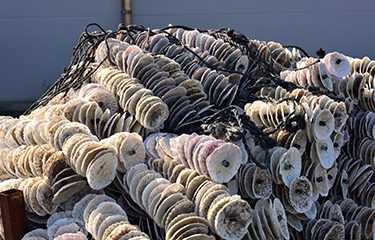The Japan Fisheries Agency (JFA) has added policies regarding non-fish aquaculture products –mainly shellfish and seaweed – to its aquaculture strategy. The new policies are meant to more fully exploit potential aquaculture sites and to take into account new rules on who can manage aquaculture sites.
Following a major reform of Japan's Fisheries Act in 2018, private companies will be able to gain access rights to aquaculture grounds that were preferentially reserved for fishery cooperatives. The document, titled “Revision of Aquaculture Growth Industrialization Comprehensive Strategy,” was released at the end of July.
In the "Reform of Fisheries Policy" announced on 1 June, 2018, the national government began formulating a comprehensive strategy for the growth of the non-fish aquaculture sector, from production to sales and export. It formed the Aquaculture Growth Industrialization Promotion Council, comprised of business groups, NGOs, and academic experts, to decide the best methods for growing the sector. The council decided on a strategy of shifting from a production-oriented focus to a market-oriented focus, in order to better meet market demands. The council then compiled the results of its shared vision as the Comprehensive Strategy for Growth and Industrialization of the Agricultural Industry.
The Comprehensive Strategy notes major trends in the aquaculture industry:
- In the past 20 years, while Japan's aquaculture industry has matured and stagnated, world aquaculture production has quadrupled, and is expected to continue to grow.
- Domestic demand for marine products will decline in the coming decades, and aquaculture production will shrink if it remains dependent on domestic demand. This is largely because Japan’s population is declining, and diets in Japan are shifting away from fish to Western-style meals featuring more meat.
- JFA is promoting appropriate and effective use of aquaculture sites to expand the scale and attract new entrants under the revised Fisheries Act.
- Technological development of large-scale offshore aquaculture and land-based aquaculture is progressing in Japan. Land-based aquaculture creates the potential to use new or artificially created fish breeds without the danger of escape.
- Unlike fish – for which the quality can be improved by controlling the feed – shellfish and seaweed farming are greatly affected by the growing environment, such as nutrient concentration and water temperature. The environment’s impact on growth was highlighted in the Seto Inland Sea, where the introduction of improved sewage treatment resulted in fewer nutrients, which has reduced seaweed and fishery production. Finding the right balance between clean water and adequate nutrient supply will be an important issue.
- Shellfish and seaweed farming does not require feeding, but labor savings have not been achieved because the cost of shucking oysters and drying seaweed and kelp is high. In 1988, there were 13,657 people employed in aquaculture, but this declined to 7,062 by 2018. The resulting labor shortage has necessitated the introduction of information and computer technology equipment and the use of more foreign workers.
JFA said it plans to create separate strategies for the domestic and export markets and will try to better link the stages of production to maximize added value. As the fishery cooperatives no longer have an exclusive right to aquaculture sites, the agency envisages five types of aquaculture management bodies that are possible under the reforms: Producer collaboration, or cooperation between multiple relatively small-scale farmers; Collaboration with producers – or cooperation of farmers and fisheries cooperatives and feed suppliers, processors, and distributors in production areas; Producer-type companies, which can expand in scale through acquisitions; Integrated companies, or the management of all or most of the farming value chain by one company; And distribution-type companies, whose primary business is distribution and sales, with the participation of farmers.
Additionally, as part of JFA's new strategy, scallops and pearls have been added to Japan's list of priority export items. Japan’s farmed scallop industry is centered on Mutsu Bay in Aomori Prefecture, where the scallops are cultivated suspended from vertical ropes with the “ear-hanging” method. Cultured pearls were developed by the Mikimoto Pearl Co. based in Toba, Mie Prefecture. It remains the leading producer.
The strategy document has set key performance indicators for all of the items to measure progress including those newly added. The 2030 production targets, and 2018 production, for the priority export items were: yellowtail (seriola quinqueradiata), with a target production of 240,000 metric tons (MT) versus the current 140,000 MT; Pacific bluefin tuna – stable production at 20,000 MT; salmon and trout, with increased production of 30,000 to 40,000 MT versus the current 20,000 MT; sea bream, with a production target of 110,000 MT versus the current 60,000 MT; newly farmed fish species such as grouper, with a targeted production of 10,000 to 20,000 MT versus no current production; scallops, with a targeted production of 210,000 MT versus the current 170,000 MT; and pearls (which are measured in value rather than tonnage), JPY 20 billion (USD 180 million, EUR 154 million) versus JPY 13.6 billion (USD 122 million, EUR 105 million).
Strategies to meet market needs include introducing the HACCP quality control method, and substituting farmed for natural fish in the domestic market based on its predictable supply and consistent product size and quality.
The Japan Food Overseas Promotion Center (JFOODO) was established to promote Japanese foods to overseas consumers. In addition to promoting yellowtail and red sea bream in the Hong Kong and Taiwan markets, it is working to increase the demand for yellowtail in the U.S.
Another organization, the Fisheries and Processed Fisheries Export Expansion Council, concentrates on arranging business meetings between local buyers and Japanese businesses, and hosting seminars on Japanese seafood products. It has focused mainly on the European Union and Southeast Asia.
Photo courtesy of JinFujiwara/Shutterstock







